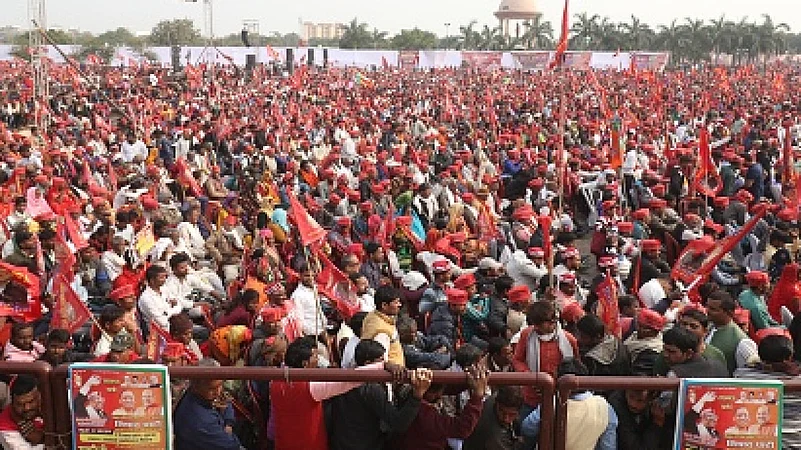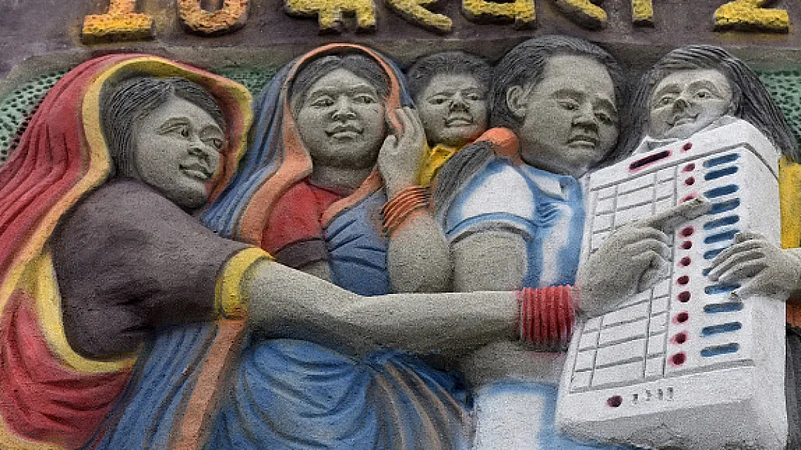The nation has been engulfed in the din of elections these days. Five states, including the largest, are holding regional elections. In the middle of all this, prominent Congress leader Rahul Gandhi said something in the parliament that triggered a political storm. He attacked the BJP-led central government by saying:
“India is described in the Constitution as a union of states and not as a nation. One cannot rule over the people of a state in India. Different languages and cultures cannot be suppressed. It is a partnership, not a kingdom.”
Gandhi didn’t say anything new, but teacup-storms are a defining feature of politics. There’s a couplet of Allama Iqbal that succinctly describes Indian democracy or even democracy per se:
'Jamhūriyat ik tarz-e-hukūmat hai ki jis meñ
bandoñ ko ginā karte haiñ taulā nahīñ karte
(Democracy is a governance system in which
People are counted but not weighed)
In a similar take on numbers versus weightage, Bahujan Samaj Party supremo and former UP chief minister Mayawati used to say that she wanted a ‘majboor’ (pliable) government in the centre instead of a ‘majboot’ (powerful) one. The pliable government are relatively more inclined to follow people’s wishes, to work in their favour. There is a fundamental difference between powerful governments and those susceptible to pressure: the former often sideline interests of different regions and social groups, while it is not possible for the latter to ignore these issues. There is a ‘strong’ government in the centre these days. Even though it is an alliance government of the NDA for appearances’ sake, the BJP could have ruled alone if it wanted. The opposition is headed by the Congress-led UPA, which suffered a crushing defeat in the last general elections. There have been repeated attempts in national politics to form a third front, but the people have offered little support to these forces.
Amid attempts to reorganize coalition politics and establish a new front, five states are undergoing elections. All eyes are on Uttar Pradesh, the state which has time and again decided the direction and discourse of national politics. The BJP is in power here on its own, but most political analysts have recognized the importance of how this party, which stands on the plank of ‘cultural nationalism,’ has made alliances with small parties based on caste identities and their interests. Examples of this include Apna Dal, which is vocal about the aspirations of the Patel community, and the SBSP (Suheldev Bharatiya Samaj Party), which seeks to represent the Rajbhars. When the SBSP broke off ties with it, the BJP brought the Nishad Party into its fold, which claims the support of the Nishad community. The ruling party is trying its hardest to neutralize any possible anti-incumbency wave against both the state and central governments.
While national parties like BJP and Congress are trying to get some new identities on board, in many states small parties based on regional aspirations are now trying to spread to other regions. For example, the JD(U), which is part of a coalition government with BJP in the politically important state of Bihar, has established a presence in Manipur. The VIP, a Nishad-community based party also from Bihar, has fielded candidates in the ongoing state elections. A host of parties that began their politics based on regional or caste identities are out to consistently assert their power to national parties. They want to ensure that the national parties are unable to ignore their agendas. A case in point is the two important parties of Bihar, the JD (U) and the RJD, which have been vocal on the demand of caste census for the OBCs, while the BJP leadership in both the state and centre is seemingly trying to avoid taking a stand on this issue. The AAP, which began its politics from the national capital Delhi – where part of the power lies with the centre - is contesting elections in states like Punjab and Goa with a fierceness that has forced the national parties to change their tactics. This became apparent when the party promised free electricity in Punjab and Goa on the lines of Delhi.

According to available data, around 40% of the world population lives in federally governed countries. There are 28 countries across the globe with federal government systems, ranging from the United States of America, often referred to as the wealthiest nation of the world, to St Kitts and Navies, a small island state. In the specific case of India, the federal or alliance politics in the centre and many states is very heterogeneous. In Bihar, both the strength and compulsions of national parties are on display. The JD (U) leads the state government despite having won lesser seats, while BJP and other parties are serving as junior alliance partners. On the other hand, the principal opposition RJD has always made it clear to its partner Congress that it has the sole claim to the driving seat of the regional coalition. In the union’s largest state UP, the main opposition Samajwadi Party has attempted to gain the support of other smaller parties and identity-based power groups. SP joining hands with Rashtriya Lok Dal, SBSP, Mahan Dal and Apna Dal (Kamerawadi) in an alliance and orchestrating the merger of Peace Party and Qaumi Ekta Dal into its fold are important moves, as it is widely accepted that the 2022 assembly election results would set the tone for the 2024 general elections. Satish Kumar Jha, a professor of political science at the Delhi University, discusses the equations between regional and national parties and the rise and mainstreaming of various identities:
“Before independence, federalism was seen from the prism of communalism. The Muslim League was prominent at this time. Subhash Chandra Bose had called Congress leaders ‘federalists,’ which was almost an accusation. But the narrative of federalism changed after independence. Federalism became an indispensable element of the Indian constitution and was legitimised. India has been home to different languages and aspirations from the North to the South and from Kashmir to the Northeast. The real problems began with coalition politics. At one point, India’s chief ministers had accumulated so much power that they could decide the prime minister. The largest party today, BJP, was not this powerful earlier, and it formed several alliances to form governments. Federalism has both its advantages and disadvantages. Our political parties have had a tendency to become authoritarian as soon as they gain power. They get drunk on power. For example, there is a difference between Vajpayee’s BJP and Modi’s BJP. Being in power on its own changes how a party rules. This is a result of our political culture.”
On the question of regional aspirations and identities within federal and alliance politics, JD (U) chief spokesperson Neeraj Kumar tells us:
“The most important thing is that the country has a federal structure and constitution. Regional parties came into existence because national parties did not prioritize regional aspirations. If you look at the recent phenomenon of Covid, there were attempts to send back UP and Bihar residents from some states, even though their economies are strengthened by our people. An atmosphere was created to insinuate that it is the labourers from UP and Bihar who were responsible for Covid. What I want to highlight is that when each state was not offered facilities that it deserved under the federal structure, the economic gap kept widening. Although this is one nation, when there are glitches in the system, sub-nationalisms come into existence. National parties do not connect to them, so it is natural that regional identities emerge. When a state demands its (fair) share, the centre answers by saying this would lead to other states demanding it too. You will have to make a distinction between developed and developing states. There cannot be a universal policy. Bihar is not a follower state, it is a leading state because the centre has adopted many of our schemes. The bottom line is, regional parties will keep coming up, and the national parties would have to understand that if they help the states, we can also be a part of the nation’s development. Identifying and targeting people living across different states as Biharis, UP-wallas and Gujaratis go against the underlying spirit of the constitution. Whatever the national parties think today, it is clear that you cannot be successful in this country’s politics by ignoring regional aspirations.”
In a federal structure, how can one justify Punjab Chief Minister Charanjit Singh Channi when he calls people from UP, Bihar and Delhi ‘bhaiyas’ and threatens to not let them enter the state? Allegations of supporting Khalistan levelled against the Delhi CM by his former party colleague Kumar Vishvas have also grabbed headlines. But analysts know that politicians do not deliver such statements out of the blue. Each political assertion has its underlying meanings and target audience. Some lash out against the Purabiyas (people from the east), while others are attempting to divert the entire electoral debate to the question of hijab, instead of talking of people’s basic needs. It is probably because of such antics that dialogue from a popular Bollywood movie – one of the industries' few interesting takes on Indian politics - is often quoted in public:
“In politics, the dead are never buried, they are kept alive to make them speak when the time comes.”



























